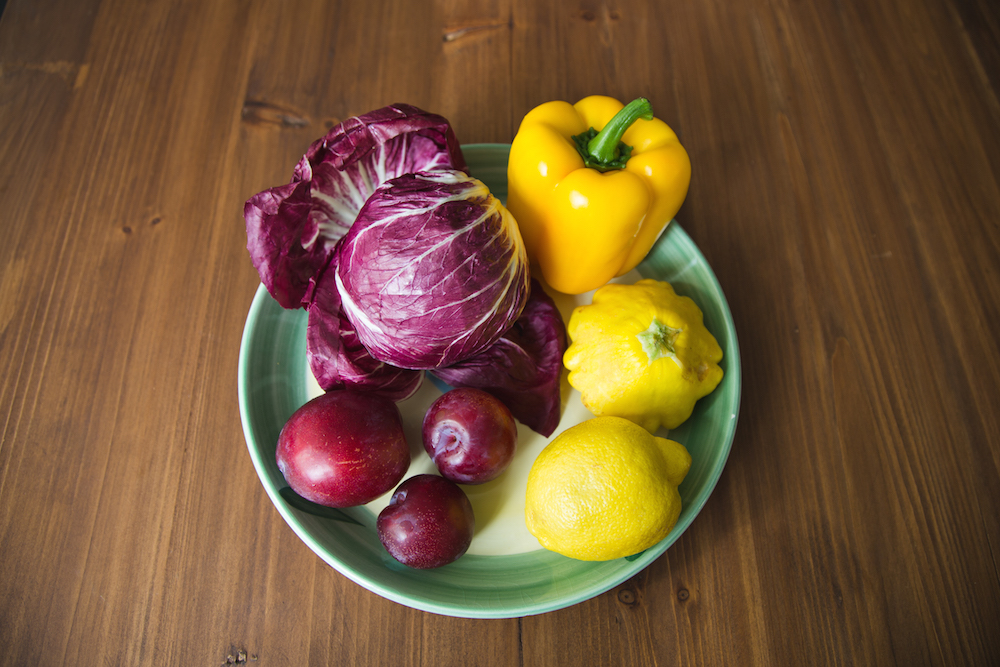
Go Purple, Be Delicious: Six Purple & Gold Tailgating Foods
The seasons are changing, and it’s time to get ready for those falling leaves. Check out this list of some great purple and gold foods to amp up your Husky-themed dinner party or tailgate like a pro.
Purple Team
1. Purple cauliflower
Purple cauliflower is almost the same as its white counterpart, but it has some extra nutritional benefits. According to specialtyproduce.com, the purple coloring in this vegetable is caused by a set of compounds called anthocyanins, which help regulate blood sugar, weight, and decrease your risk for developing cancer.
This type of cauliflower also tastes nuttier and less bitter than other types. Combine that with purple cauliflower’s glucoraphanin — one of the same compounds found in broccoli — and you get a great tasting food that really packs a nutrient-filled punch.
Quick Nutrition:
1 cup of raw cauliflower
Calories – 20
Dietary Fiber – 2g
Sugars – 2g
Protein – 2g
Vitamin C – 94% (DV)
Vitamin K – 16% (DV)
Suggestion: Cooking cauliflower diminishes its nutritious benefits, so eat this veggie fresh or as an add-in a colorful salad to keep it at maximum vitamin capacity.
2. Purple Belgian Endive
Endives come in a number of types with similar nutrition facts, but purple Belgian endive stands out as the leader due to its impeccable color choice. Like many others on this list, endives are a great source of Vitamin C, but they also provide 100% of your daily value for four different vitamins and minerals in one head of endive alone. With this vegetable on your dinner table, you’ll never have to go out of your way to find a source of Vitamin K again.
Quick Nutrition:
1 head of endive
Calories – 87
Dietary Fiber – 16g
Sugars – 1g
Protein – 6g
Vitamin K – 1481% (DV)
Vitamin A – 222% (DV)
Suggestion: Want to really wow the folks you love with practically no effort? Check out this purple endive and crab salad for an aesthetically pleasing, yet flavorful party food.
3. Plums
The first of team purple to not actually utilize the color in its name, plums are rich in Vitamin C, and are a great source of everyone’s favorite carbohydrate: fiber, a naturally occurring laxative that helps your digestive track do its job. Ironically enough, fiber is indigestible for humans, but that means it can also help with controlling blood sugar levels by slowing down the rate at which food leaves the stomach. They’re only in season until late September. Start planning your plum parties now!
Quick Nutrition:
1 cup of raw plums
Calories – 76
Dietary Fiber – 2g
Sugars – 16g
Protein – 1g
Vitamin A – 11% (DV)
Vitamin C – 26% (DV)
Suggestion: If you plan on buying plums before they are fully ripe, avoid putting them in the fridge: they’ll get too cold and lose their delicious flavor. After they’re ripe, you can store them in the fridge for up to five days and still achieve flavor greatness.
Gold Team
1. Summer Squash
Despite the name, you can actually find good squash all year. Like plums, a lot of the calories come from sugars, but squash is also a good source for manganese, which regulates your brain and nervous system. It’s a great source of Vitamin B6, which helps keep the immune system working like a well-oiled machine. While preparing squash, try to avoid grilling or boiling it; it’ll maintain more of its nutritional value if you steam it instead.
Quick Nutrition:
1 cup of sliced squash
Calories – 18
Dietary Fiber – 1g
Sugars – 2g
Protein – 1g
Vitamin B6 – 12% (DV)
Manganese – 10% (DV)
Suggestion: Rather than using your squash for another soup, here’s a recipe to use that will impress both your friends and your taste buds.
2. Yellow bell peppers
Bell peppers of different color variation are actually almost identical, and it turns out that one of the main differences between them all is just stage of ripeness. Green peppers are the least ripe, red the most, with yellow right in between. Because of this, yellow peppers get the best of both worlds, providing more Vitamin C than red peppers and more potassium than green. Plus, they’re delicious, so yellow bell peppers are a must use for any recipes upcoming this fall.
Quick Nutrition:
1 large yellow bell pepper
Calories – 50
Dietary Fiber – 2g
Sugars – 10g
Protein – 2g
Vitamin B6 – 16% (DV)
Potassium – 11%
Suggestion: Who doesn’t love nachos? Here’s a unique nacho recipe to mix it up with a delicious new spin on a classic favorite.
3. Lemons
Our final food isn’t the sweetest one around, but it comes with some sweet nutritional benefits. One cup of lemon juice has approximately 187% of your daily value of Vitamin C. It also has a good amount of potassium and folate, which is great news for your intestinal tract and bones. Adding a slice of lemon or a teaspoon of lemon juice to your water bottle every day is also a refreshing alternative to drinking sodas, and it will save you from dental damage down the road.
Quick Nutrition:
1 raw lemon
Calories – 22
Dietary Fiber – 5g
Sugars – 7g
Protein – 1g
Vitamin B6 – 6% (DV)
Calcium – 7% (DV)
Suggestion: Make your tailgate the life of the party by inviting your friends to try this Lemon Parmesan Wings recipe I found, and tell us what your taste buds think in the comment section below!
I found the nutrition and daily values that I used in this article on http://nutritiondata.self.com. Since I’m no dietician, I had to learn a lot from the Internet while writing this article. Before making any significant changes to your diet, or if you want more information on a particular ingredient, consult a professional. Happy eating!